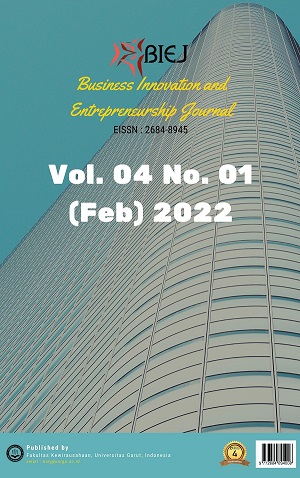Faktor-Faktor yang Mempengaruhi Keputusan Penggunaan Telemedicine saat Pandemi COVID-19
Abstract
Abstract – The emergency COVID-19 pandemic bring anxiety in the world and has changed cunsomer behaviour especially in decision to use technoly in health sector. Digital health care changing cunsomer behaviour from using conventional health service to digital. Health technology, telemedicine designed for long-distance communication between doctor and patient which is considered to bring effectiveness and effictiveness during COVID-19 pandemic. This research aim to exemain perceived fear, quality of information and trust to use telemedicine during corona virus plague. This study focus on Halodoc users aged 17-45 year and using a non-probablity technique sampling. 125 respondents were collected using online questionnare. Data were analyzed using multipel linear regression method. The result showed, the information quality and trust had asignificant effect on desicion to use M-health. However, Perceived fear has a negative effect on customer desicions in using M-health.
Abstrak -- Keadaan darurat wabah virus COVID-19 menyebabkan kegelisahan pada masyarakat dunia dan banyak merubah perilaku konsumen terutama dalam keputusan penggunaan teknologi dibidang kesehatan. Perawatan kesehatan secara digital mengubah perilaku konsumen dari penggunaan jasa kesehatan konsenvisonal menjadi digital. Teknologi kesehatan, telemedicine yang dirancang untuk komunikasi jarak jauh antara penyedia jasa kesehatan dengan konsumen yang dinilai membawa efektivitas dan efisiensi pada saat pandemi COVID-19. Dalam hal ini peneliti menguji perceived fear, kualitas informasi dan kepercayaan terhadap keputusan penggunaan telemedicine saat pandemi COVID-19. Penelitian ini berfokus pada pengguna M-Health Halodoc dengan rentan usia 17-45 tahun menggunakan sampel non probability teknik. 125 responden dikumpulkan dengan menggunakan kuisioner online. Data dianalisis menggunakan metode regresi linear beraganda. hasil penelitian menunjukkan kualitas informasi dan kepercayaan berpengaruh signifikan terhadap keputusan penggunaan aplikasi kesehatan. Namun, perceived fear atau rasa takut berpengaruh negatif terhadap keputusan konsumen dalam menggunakan aplikasi kesehatan.
Downloads
References
R. Tjandrawinata, “Industri 4.0: revolusi industri abad ini dan pengaruhnya pada bidang kesehatan dan bioteknologi,” no. April, 2016, doi: 10.5281/zenodo.49404.
N. A. Hamdani, A. Solihat, and G. A. F. Maulani, “The Influence of Information Technology and Co-Creation on Handicraft SME Business Performance,” Int. J. Recent Technol. Eng., vol. 8, no. 1S, pp. 151–154, 2019, [Online]. Available: https://www.ijrte.org/download/volume-8-issue-1s/.
R. Setiawan, “Faktor-Faktor yang Mempengaruhi Permintaan Jasa Pariwisata Pemandian Air Panas,” Bus. Innov. Entrep. J., vol. 1, no. 1, pp. 53–61, 2019, [Online]. Available: http://ejournals.fkwu.uniga.ac.id/index.php/BIEJ.
Lindayani, “Pelayanan Jasa Keperawatan : Tingkat Kepuasan Pasien pada Unit Rawat Inap Rumah Sakit Umum ‘ dr . Slamet ’ Garut,” Bus. Innov. Entrep. J., vol. 1, no. 2, pp. 93–97, 2019, doi: 10.35899/biej.v1i2.59.
S. Setiati and M. K. Azwar, “COVID-19 and Indonesia,” Acta Med. Indones., vol. 52, no. 1, pp. 84–89, 2020.
S. Rahi, M. M. Khan, and M. Alghizzawi, “Factors influencing the adoption of telemedicine health services during COVID-19 pandemic crisis: an integrative research model,” Enterp. Inf. Syst., vol. 15, no. 6, pp. 769–793, 2021, doi: 10.1080/17517575.2020.1850872.
A. C. Smith et al., “Telehealth for global emergencies: Implications for coronavirus disease 2019 (COVID-19),” J. Telemed. Telecare, vol. 26, no. 5, pp. 309–313, 2020, doi: 10.1177/1357633X20916567.
S. Ryu, “Telemedicine: Opportunities and Developments in Member States: Report on the Second Global Survey on eHealth 2009 (Global Observatory for eHealth Series, Volume 2),” Healthc. Inform. Res., vol. 18, no. 2, p. 153, 2012, doi: 10.4258/hir.2012.18.2.153.
A. I. Albarrak et al., “Assessment of physician’s knowledge, perception and willingness of telemedicine in Riyadh region, Saudi Arabia,” J. Infect. Public Health, vol. 14, no. 1, pp. 97–102, 2021, doi: 10.1016/j.jiph.2019.04.006.
R. R. Pai and S. Alathur, “Assessing awareness and use of mobile phone technology for health and wellness: Insights from India,” Heal. Policy Technol., vol. 8, no. 3, pp. 221–227, 2019, doi: 10.1016/j.hlpt.2019.05.011.
D. J. Hunter, “Engla, Journal - 2010 - New engla nd journal,” N. Engl. J. Med., vol. 31, no. 1, pp. 1969–73, 2020.
G. S. Octavius and F. Antonio, “Antecedents of Intention to Adopt Mobile Health (mHealth) Application and Its Impact on Intention to Recommend: An Evidence from Indonesian Customers,” Int. J. Telemed. Appl., vol. 2021, no. March 2019, 2021, doi: 10.1155/2021/6698627.
E. Shin, “Pandemic Fear and Weight Gain: Effects on Overweight and Obese Adults’ Purchasing Exercise Apparel Online,” Cloth. Text. Res. J., vol. 39, no. 3, pp. 232–246, 2021, doi: 10.1177/0887302X211004892.
R. S. Al-Maroof, S. A. Salloum, A. E. Hassanien, and K. Shaalan, “Fear from COVID-19 and technology adoption: the impact of Google Meet during Coronavirus pandemic,” Interact. Learn. Environ., 2020, doi: 10.1080/10494820.2020.1830121.
S. J. Eder et al., “Predicting fear and perceived health during the COVID-19 pandemic using machine learning: A cross-national longitudinal study,” PLoS One, vol. 16, no. 3 March, pp. 1–16, 2021, doi: 10.1371/journal.pone.0247997.
W. H. DeLone and E. R. McLean, “Information systems success: The quest for the dependent variable,” Inf. Syst. Res., vol. 3, no. 1, pp. 60–95, 1992, doi: 10.1287/isre.3.1.60.
F. Meng, X. Guo, Z. Peng, K. H. Lai, and X. Zhao, “Investigating the adoption of mobile health services by elderly users: Trust transfer model and survey study,” JMIR mHealth uHealth, vol. 7, no. 1, 2019, doi: 10.2196/12269.
D. Wu, H. Gu, S. Gu, and H. You, “Individual motivation and social influence: a study of telemedicine adoption in China based on social cognitive theory,” Heal. Policy Technol., vol. 10, no. 3, 2021, doi: 10.1016/j.hlpt.2021.100525.
F. Saigi-Rubió, A. Jiménez-Zarco, and J. Torrent-Sellens, “Determinants of the intention to use telemedicine: Evidence from primary CARE PHYSICIANS,” Int. J. Technol. Assess. Health Care, vol. 32, no. 1–2, pp. 29–36, 2016, doi: 10.1017/S0266462316000015.
S. A. Kamal, M. Shafiq, and P. Kakria, “Investigating acceptance of telemedicine services through an extended technology acceptance model (TAM),” Technol. Soc., vol. 60, no. March 2019, p. 101212, 2020, doi: 10.1016/j.techsoc.2019.101212.
C. Division, “Implementing e-Health in Developing Countries Guidance and Principles,” no. September, 2008.
L. van Dyk, “The Development of a Telemedicine Service Maturity Model,” no. December, pp. 1–296, 2013.
A. Alaboudi, A. Atkins, B. Sharp, A. Balkhair, M. Alzahrani, and T. Sunbul, “Barriers and challenges in adopting Saudi telemedicine network: The perceptions of decision makers of healthcare facilities in Saudi Arabia,” J. Infect. Public Health, vol. 9, no. 6, pp. 725–733, 2016, doi: 10.1016/j.jiph.2016.09.001.
B. Ilham Ramadhan and T. Pradekso, “Hubungan Antara Terpaan Iklan Aplikasi Halodoc Dan Terpaan Persuasi Reference Group Dengan Minat Untuk Menggunakan Aplikasi Halodoc Sebagai Sarana Konsultasi Dengan Dokter,” Interak. Online, vol. 9, no. 1, 2020.
A. A. Pratama and A. B. Mutiara, “Software Quality Analysis for Halodoc Application using ISO 25010:2011,” Int. J. Adv. Comput. Sci. Appl., vol. 12, no. 8, 2021, doi: 10.14569/IJACSA.2021.0120844.
J. F. Engel, R. D. Blackwell, and P. W. Miniard, Consumer Behavior, 8th Ed. Texas: The Dryden Press, 1995.
M. A. Shareef, Y. K. Dwivedi, and V. Kumar, “Online Consumer Behavior and Marketing,” in Mobile Marketing Channel Online Consumer Behavior, 1st ed., Springer International Publishing, 2016.
D. Rofifah, “済無No Title No Title No Title,” Pap. Knowl. . Towar. a Media Hist. Doc., no. 2009, pp. 12–26, 2020.
N. R. YUNITA, H. SUMARSONO, and U. FARIDA, “PENGARUH PERSEPSI RISIKO, KEPERCAYAAN, DAN KEAMANAN TERHADAP KEPUTUSAN PEMBELIAN ONLINE DI BUKA LAPAK (Studi Kasus Pada Komunitas Buka Lapak Ponorogo),” ISOQUANT J. Ekon. Manaj. dan Akunt., vol. 3, no. 1, p. 90, 2019, doi: 10.24269/iso.v3i1.243.
K. Alhumaid, M. Habes, and S. A. Salloum, “Examining the Factors Influencing the Mobile Learning Usage during COVID-19 Pandemic: An Integrated SEM-ANN Method,” IEEE Access, vol. 9, pp. 102567–102578, 2021, doi: 10.1109/ACCESS.2021.3097753.
D. K. Ahorsu, C. Y. Lin, V. Imani, M. Saffari, M. D. Griffiths, and A. H. Pakpour, “The Fear of COVID-19 Scale: Development and Initial Validation,” Int. J. Ment. Health Addict., 2020, doi: 10.1007/s11469-020-00270-8.
L. Gerhold, “COVID-19: Risk perception and Coping strategies.,” pp. 1–11, 2020, doi: 10.31234/osf.io/xmpk4.
A. Alsaad and M. Al-Okaily, “Acceptance of protection technology in a time of fear: the case of Covid-19 exposure detection apps,” Inf. Technol. People, no. July, 2021, doi: 10.1108/ITP-10-2020-0719.
O. A. Alshikhi and B. M. Abdullah, “Information quality : definitions, measurement, dimensns, and relationship with decision making,” Eur. J. Bus. Innov. Res., vol. 6, no. 5, pp. 36–42, 2018.
F. Alharbi, “The use of digital healthcare platforms during the COVID-19 pandemic: The consumer perspective,” Acta Inform. Medica, vol. 29, no. 1, pp. 51–58, 2021, doi: 10.5455/AIM.2021.29.51-58.
C. Y. Hui, B. McKinstry, O. Fulton, M. Buchner, and H. Pinnock, “Patients’ and clinicians’ perceived trust in internet-of-things systems to support asthma self-management: Qualitative interview study,” JMIR mHealth uHealth, vol. 9, no. 7, 2021, doi: 10.2196/24127.
T. S. Alotaibi, A. A. Alkhathlan, and S. S. Alzeer, “Instagram shopping in Saudi Arabia: What influences consumer trust and purchase decisions?,” Int. J. Adv. Comput. Sci. Appl., vol. 10, no. 11, pp. 605–613, 2019, doi: 10.14569/IJACSA.2019.0101181.
R. A. Rather, “Monitoring the impacts of tourism-based social media, risk perception and fear on tourist’s attitude and revisiting behaviour in the wake of COVID-19 pandemic,” Curr. Issues Tour., vol. 0, no. 0, pp. 1–9, 2021, doi: 10.1080/13683500.2021.1884666.
B. Xie, Z. Su, W. Zhang, and R. Cai, “Chinese cardiovascular disease mobile apps’ information types, information quality, and interactive functions for self-management: Systematic review,” JMIR mHealth uHealth, vol. 5, no. 12, 2017, doi: 10.2196/mhealth.8549.
I. Ningrum and A. Purnomo, “Jurnal Penelitian IPTEK-KOM PENGUKURAN KUALITAS LAYANAN WEBSITE KEMENTERIAN KOMINFO DENGAN MENGGUNAKAN METODE WE ...”
A. dhiah Maharani, “Analisi Pengaruh Kepercayaan dan Kepuasan Terhadap Loyalitas Nasbah tabungan Bank Mega semarang,” Navigation, p. 129, 2010.
B. Adityo, “Kepercyaan Kemudahan Pada Kaskus,” Skripsi Fak. Ekon. Univ. DIponegoro, 2011.
F. E. Hahn, Beriklan dan Berpromosi Sendiri. Jakarta: PT. Gramedia. Pustaka Utama., 2002.
D. Gu, G. Humbatova, Y. Xie, X. Yang, O. Zolotarev, and G. Zhang, “Different roles of telehealth and telemedicine on medical tourism: An empirical study from Azerbaijan,” Healthc., vol. 9, no. 8, 2021, doi: 10.3390/healthcare9081073.
X. Guo, S. Chen, X. Zhang, X. Ju, and X. Wang, “Exploring patients’ intentions for continuous usage of mHealth services: Elaboration-likelihood perspective study,” JMIR mHealth uHealth, vol. 8, no. 4, 2020, doi: 10.2196/17258.
T. Dahlberg, N. Mallat, and A. Öörni, “Trust enhanced technology acceptance model - consumer acceptance of mobile payment solutions,” Stock. Mobil. Roundtable, no. January 2003, pp. 22–23, 2003.
M. R. Hoque, Y. Bao, and G. Sorwar, “Investigating factors influencing the adoption of e-Health in developing countries: A patient’s perspective,” Informatics Heal. Soc. Care, vol. 42, no. 1, pp. 1–17, 2017, doi: 10.3109/17538157.2015.1075541.
G. S. Mbete and R. Tanamal, “Effect of Easiness, Service Quality, Price, Trust of Quality of Information, and Brand Image of Consumer Purchase Decision on Shopee Online Purchase,” J. Inform. Univ. Pamulang, vol. 5, no. 2, p. 100, 2020, doi: 10.32493/informatika.v5i2.4946.



























